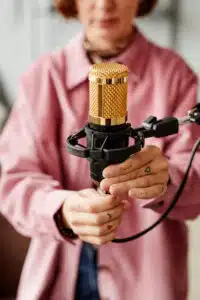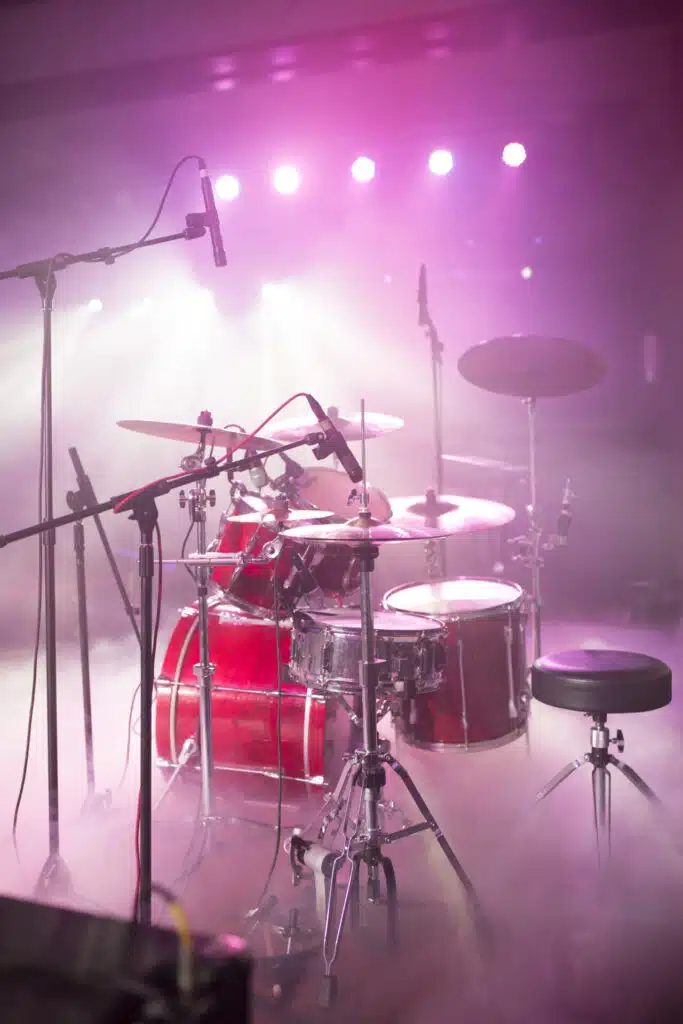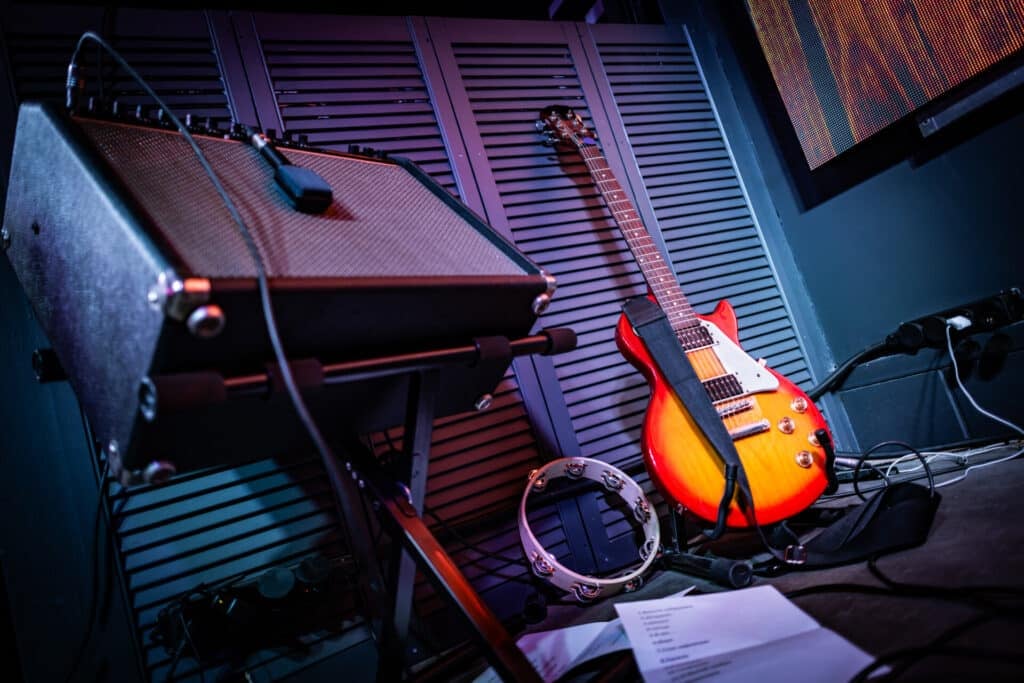Want to record your band but microphone options got you stressed? Don’t worry, F.I.R.S.T. Institute is here to help! As an audio engineering school we can help answer all your microphone questions. Today, we’ll crack the mic code and answer: What microphones should you use to record a live band?
Now, this is a loaded question, as there are many techniques that can be implemented, different environments to consider, and what instruments are being recorded. But to keep it simple, we will focus on recording the band in a controlled environment (i.e., recording studio, home studio, church hall); we will imagine we are recording the band all at once, and for instruments, we have an acoustic guitar, electric guitar, bass guitar, drum set, and vocals.
This a really funky band we have here! But this will give you insight into the types of mics used for each instrument and why.
3 Types of Microphones Used For Recording Bands
Before getting into the nitty-gritty of the microphones you will be using to record your live band, let’s discuss the different types of microphones available. Each one has its pros and cons, but the important thing to know is that no matter what microphone you use, a good audio engineer will know exactly how to pull the most out of each.
Condenser Microphone: The Sensitive Soul (2 types Large & Small Diaphragm)
- Think of it as: A finely tuned whisperer, capturing every breath and nuance.
- How it works: A thin diaphragm dances with sound waves, generating electrical signals.
- Sounds best with: Vocals, acoustic instruments, delicate sounds, capturing detail.
- Personality: High-maintenance, needs phantom power, fragile, but oh-so-accurate.
- Think of it in action: A singer’s confidante, revealing the beauty in their every sigh.
Dynamic Microphone: The Tough Performer
- Think of it as: A rugged rockstar, unfazed by loud and rowdy.
- How it works: A moving coil dances within a magnetic field, creating electricity.
- Sounds best with: Drums, loud instruments, live performances, handling high sound pressure.
- Personality: Durable, low-maintenance, works anywhere, loves to be heard.
- Think of it in action: A drummer’s best friend, taming the thunderous roar of a cymbal crash.
Ribbon Microphone: The Smooth Vintage Maestro
- Think of it as: A velvety voice from another era, adding warmth and character.
- How it works: A thin metal ribbon sways with sound waves, generating an elegant electrical current.
- Sounds best with: Vocals, horns, strings, adding warmth and smoothing harshness.
- Personality: Delicate, needs careful handling, loves controlled environments, adds a touch of magic.
- Think of it in action: A vocalist’s secret weapon, infusing their voice with a timeless, smooth richness.
So, What Microphones should You Use To Record A Live Band?
The simple answer is: a combination of dynamic and condenser microphones. However, transforming the raw energy of a live band into a captivating recording is an art form, and microphone placement plays a starring role. Here’s a crash course on micing up a typical band setup:
- Drums: The heart of the rhythm section deserves a thoughtful approach. Start with a kick drum mic (like a Shure Beta 52) placed slightly off-center, aiming towards the beater for punch and power. If possible we’d recommend setting ups another mic on the outside of the kick drum. Capture the snare’s crack with a dynamic mic (like a Shure SM57) angled towards the rim for attack and bite. Overhead mics, like a pair of cardioid condensers (e.g., AKG C414s), capture the overall kit sound. For cymbals, consider spot mics for crucial hi-hats or rides.
- Bass: A direct injection (DI) box is often preferred, tapping the signal directly from the bass for a clean, consistent tone. However, if you are recording the band performing together, it is wise to set up a mic like the sm57 or sm58 in front of the bass amp to catch its natural character.
- Guitars: For electric guitars, dynamic mics like the Shure SM57 are popular, placed slightly off-axis to the speaker cone for a balanced sound. For acoustic guitars, condenser mics (e.g., Neumann KM 184) capture the nuanced strumming and picking. Experiment with placement near the soundhole or body for different tonal variations.
- Lead Vocals: The Shure SM7B or SM58 is a dynamic powerhouse built for live performance. Its smooth frequency response captures every detail, from breathy intimacy to electrifying shrieks. Position it slightly off-axis to avoid plosives and find the sweet spot where the voice blooms with richness and clarity.
- Backing Vocals: Consider the SM7B or SM58 positioned directly in front of the singers. This will help capture the natural spread and interplay of the harmonies, adding depth and dimension to the vocal mix.
Other Things To Consider Before Hitting Record
Mic placement and selection are crucial, but remember – your sonic journey doesn’t end there! Before you hit record, let’s ensure everything’s primed for capturing that live band magic:
Gearing Up for Input:
- Interface Intermission: You’ve meticulously placed your mics, now you need a way to communicate that sonic bounty to your recording software. Enter the audio interface – your trusty bridge between instruments and digital realm. Ensure your interface has enough channels to accommodate all your microphones. If your band’s a large ensemble, consider expanding your interface or utilizing a digital snake for greater input flexibility.
- Level Up Your Levels: Before recording, do a soundcheck with the band. This is your chance to individually adjust each mic’s gain level, ensuring every instrument and vocalist shines through without clashing or getting lost in the mix. Aim for balanced levels, leaving some headroom for those electrifying peak moments.
- Monitoring Matters: Having a clear and accurate monitor mix for the band is key to their performance. Use your interface’s headphone outputs or separate stage monitors to provide a comfortable mix for each musician. This helps them stay in sync and deliver their best takes.
Remember:
- Testing, Testing: Always do a test recording before diving into the full performance. This helps you identify any technical issues like clipping, unwanted noise, or imbalances in the mix, allowing you to adjust before the cameras roll (or in this case, the record button gets pressed).
- Preparation is Power: Taking the time to set up properly will save you precious time and frustration during the actual recording. Think of it as building a solid foundation for your sonic edifice – the better the base, the higher you can build your musical masterpiece!
Microphones Worth Mentioning:
The microphone market is huge, so we wanted to make an extra list of microphones we would recommend checking out:
- Audio Technica: Known for their robust design and reliability, Audio Technica’s AE, AT, and ATM models are excellent choices for overhead and room mics. Think crisp cymbals and lively ambience.
- sE Microphones: Offering high-quality microphones at affordable prices, sE is a newcomer making waves in the music industry—perfect for the working musician on a budget. Think smooth vocals and bright acoustics.
- Avantone: Despite being a smaller manufacturer, Avantone stands out with aesthetically pleasing microphones and a commitment to excellent customer service. Think vintage vibes and characterful recordings.
- AKG C414: A multi-pattern studio workhorse, the C414 offers nine polar patterns for unparalleled versatility. Ideal for capturing the nuanced richness of acoustic instruments and vocals. Consider it a chameleon of the microphone world.
Shure Mic Standouts:
- Shure SM57: The industry standard for live sound recording, renowned for its versatility and rugged design.Think punchy snares and gritty guitars.
- Shure SM81: A unidirectional condenser offering precise sound capture without excessive background noise.Think detailed acoustic guitars and crisp piano recordings.
- Shure Beta 52: Originally designed for kick drums and toms, optimized for delivering powerful bass tones. Think thunderous kicks and boomy toms.
- Shure SM58: A legendary vocal microphone, both in the studio and on the road, setting the industry standard for vocals. Think clear and reliable performances.
Sennheiser Gems:
- Sennheiser 421: Sennheiser’s equivalent to the SM57, offering clear sound with additional bass EQ control. Think versatile dynamics for guitars and drums.
- Sennheiser 409 (discontinued): While no longer in production, this versatile microphone was popular for vocals,drums, and horns. Think a classic all-rounder.
- Sennheiser 604: A dedicated drum microphone with an ingeniously engineered clip for easy attachment to toms and snares. Think focused mic placement and precise drum tones.
Now, to be a pro audio engineer, you need more than just knowing which mics to use for live band recording. It involves a wide range of knowledge and skills related to audio production. You need to learn how to use recording equipment. You also need to learn how to mix and master audio tracks. Additionally, you should know how to fix technical problems. Lastly, it is important to be able to work well with musicians and other professionals in the industry.
To gain a comprehensive understanding of audio engineering, it is highly recommended that you receive formal education from a reputable institution. F.I.R.S.T. Institute is a top audio engineering school in Florida. They offer classes on campus and online to help you gain the skills and experience necessary for success in this field. Their programs teach audio engineering and music production basics, advanced techniques, and industry-standard software and hardware.
Our program prepares you for a successful career in Recording Arts and Show Production. It teaches you how to work in the audio industry. You will gain hands-on experience and receive guidance from professionals. Be sure to book your personalized virtual tour to see how F.I.R.S.T. Institute can help your passion become a profession.






